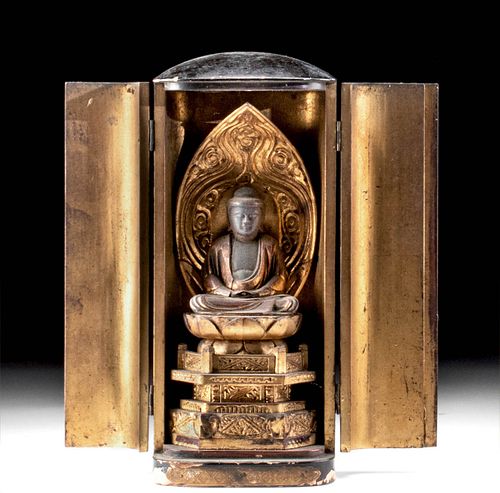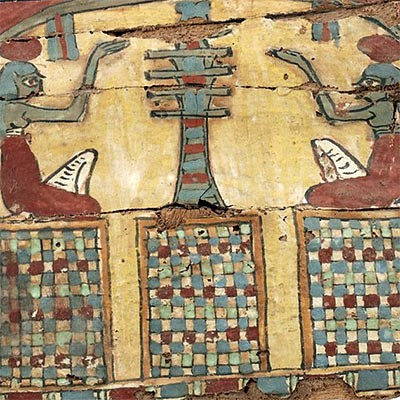Japanese Meiji Period Gold & Wood Zushi Shrine
Lot 79
About Seller
Artemis Gallery
686 S Taylor Ave, Ste 106
Louisville, CO 80027
United States
Selling antiquities, ancient and ethnographic art online since 1993, Artemis Gallery specializes in Classical Antiquities (Egyptian, Greek, Roman, Near Eastern), Asian, Pre-Columbian, African / Tribal / Oceanographic art. Our extensive inventory includes pottery, stone, metal, wood, glass and textil...Read more
Categories
Estimate:
$600 - $900
Absentee vs Live bid
Two ways to bid:
- Leave a max absentee bid and the platform will bid on your behalf up to your maximum bid during the live auction.
- Bid live during the auction and your bids will be submitted real-time to the auctioneer.
Bid Increments
| Price | Bid Increment |
|---|---|
| $0 | $25 |
| $300 | $50 |
| $1,000 | $100 |
| $2,000 | $250 |
| $5,000 | $500 |
| $10,000 | $1,000 |
| $20,000 | $2,500 |
| $50,000 | $5,000 |
| $100,000 | $10,000 |
| $200,000 | $20,000 |
About Auction
By Artemis Gallery
Jul 30, 2020
Set Reminder
2020-07-30 10:00:00
2020-07-30 10:00:00
America/New_York
Bidsquare
Bidsquare : Ancient / Ethnographic From Around the World
https://www.bidsquare.com/auctions/artemis-gallery/ancient-ethnographic-from-around-the-world-5382
Ancient art from Egypt, Greece, Italy and the Near East, as well as Asian, Pre-Columbian, Native American, African / Tribal / Oceanic, Spanish Colonial, Russian Icons, Fine art, much more! All categories, all price ranges... all legally acquired and guaranteed to be as described or your money back. Artemis Gallery info@artemisgallery.com
Ancient art from Egypt, Greece, Italy and the Near East, as well as Asian, Pre-Columbian, Native American, African / Tribal / Oceanic, Spanish Colonial, Russian Icons, Fine art, much more! All categories, all price ranges... all legally acquired and guaranteed to be as described or your money back. Artemis Gallery info@artemisgallery.com
- Lot Description
East Asia, Japan, Meiji Period, ca. 1880 CE. A finely carved wooden zushi (a small Buddhist shrine) portraying a seated Buddha in a meditative pose with a layer of 30% gold adorning the elaborate mandorla, interior walls and doors, and pedestal. Buddha's face is peaceful and he is dressed in flowing robes, seated on a lotus throne which is in turn placed upon an intricately carved pedestal. The level of detail on this piece is very impressive. Buddhist statues in Japan frequently reside in zushi, wooden shrines with doors that can both reveal or conceal the deity within. Some scholars trace this Japanese interpretation of a Buddhist practice to Shinto shrines, where it is rare to find a statue and they are always concealed. Size (shrine): 4.15" W x 9.75" H (10.5 cm x 24.8 cm); (interior figure w/ base): 3.25" W x 7.8" H (8.3 cm x 19.8 cm) Gold quality: 30%, equivalent < 8K.
At the start of the Meiji Period (1868), the Japanese government declared that Buddhism must be separated from Shinto, the official state religion. Initially, enforcement of the separation was strict, and Buddhist images were stricken from many Shinto shrines. Within a few years, however, enforcement stopped and Buddhist images crept back into Japanese religious art. A shrine like this one, depicting a Buddha was created during this time period.
Provenance: private New Jersey, USA collection
All items legal to buy/sell under U.S. Statute covering cultural patrimony Code 2600, CHAPTER 14, and are guaranteed to be as described or your money back.
A Certificate of Authenticity will accompany all winning bids.
We ship worldwide and handle all shipping in-house for your convenience.
#156739Nicks and abrasions to exterior, interior surfaces, and figure, with small chip to base periphery, and minor darkening to exterior pigment, otherwise intact and very good. Nice detailing to figure.Condition
- Shipping Info
-
All shipping is handled in-house for your convenience. Your invoice from Artemis Gallery will include shipping calculation instructions. If in doubt, please inquire BEFORE bidding for estimated shipping costs for individual items.
-
- Buyer's Premium



 EUR
EUR CAD
CAD AUD
AUD GBP
GBP MXN
MXN HKD
HKD CNY
CNY MYR
MYR SEK
SEK SGD
SGD CHF
CHF THB
THB















